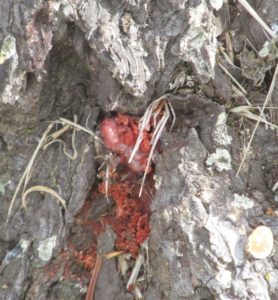“If April showers bring May flowers, then what do Mayflowers bring?”
As we get into Spring and the weather warms we find new challenges in our trees. Ash, both Modesto and Raywood, are susceptible to Anthracnose. Sycamores are very susceptible as well. If new leaves are small, distorted, die and fall off, it is very likely Anthracnose. As the weather gets hotter and dries out, a new crop of leaves will be produced. It may help to spray with a fungicide now, however fall injections are most efficient.

There is a problem new to this area. It is commonly called European Pear Rust. This fungus (Gymnosporangium sabinae) actually has two hosts. It spends the fall and winter on Junipers or Cedars and the spring and summer on Pears. Orange gelatinous finger-like growth occur on the underside of Juniper twigs in the spring. They release spores that, according to several sources, can travel up to four miles and infect Pear leaves. The Pear leaves develop bright yellow, orange, or red spots on the leaves. Orange pustules develop in the spots and release spores in the early fall to reinfest the Junipers.

It doesn’t seem to harm the Junipers and is mostly unsightly on Pears. Prolonged and extensive infestation of Pears may cause twig dieback and reduce fruiting. Pruning out infected branches is the only control I have seen for Junipers. If you have Junipers under or near your Pears, you may want to remove them if this becomes a significant problem. Prune or strip off infected leaves as feasible. Thinning the Pears during the fall or winter may be helpful. It is recommended Pears be sprayed every 7-10 days during April and May to prevent infection. A fungicide with the active ingredient Myclobutanil is recommended. The Pears can be injected, but I’m told this has not proven effective.
Monterey Pines should also be getting our attention. Starting next month: irrigate. These trees should get a good soaking with a deep root irrigator (spiky thingy) every 2-3 weeks into October or when it starts raining. Get your Redwoods and Magnolias too.

Keeping trees healthy is the best defense against pathogens. Stop trimming your Monterey Pines until fall. Cut branches release a fragrance that actually attracts Red Turpentine Beetle. These attack near the root crown and if a tree is stressed will cause it to decline more rapidly and even die. Look for what looks like white or pinky purple sawdust near the base of the tree. Fresh entries will look like yellow or purple volcano like tubes. Spraying or injecting with an insecticide may also be helpful.
So be alert and contact your favorite arborist if you see anything that concerns you.
“Mayflowers bring Pilgrims”
By James S. Duncan, ISA Certified Arborist
